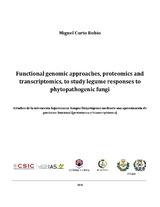Functional genomic approaches, proteomics and transcriptomics, to study legume responses to phytopathogenic fungi
Estudio de la interacción leguminosas-hongos fitopatógenos mediante una aproximación de genómica funcional (proteómica y transcriptómica)
Autor
Curto Rubio, Miguel
Director/es
Jorrín-Novo, Jesús V.Rubiales, Diego
Maldonado-Alconada, Ana M.
Editor
Universidad de Córdoba, Servicio de PublicacionesFecha
2015Materia
LeguminosasInfección de hongos fitopatógenos
Aproximación genómica funcional
Proteómica
Transcriptómica
Legume
Phytopathogenic fungi
Functional genomic approach
Proteomics
Transcriptomics
METS:
Mostrar el registro METSPREMIS:
Mostrar el registro PREMISMetadatos
Mostrar el registro completo del ítemResumen
The objectives pursued in this PhD thesis are to study the legume responses to
phytopathogenic fungi by using a functional genomics approach (transcriptomics and
proteomics). The pea (Pisum sativum) and the model legume Medicago truncatula were
chosen to study their stress responses to Erysiphe pisi and Mycosphaerella pinodes
pathogens. The pea crop constitutes an important source of protein for human
consumption, being one of the most grown grain legume in the world, meanwhile M.
truncatula is an important forage legume which is being used as a model plant for use in
molecular and classical genetic studies. Moreover, within the phytopathogenic fungi,
powdery mildew and ascochyta blight are one the most plant pathogenic fungi that
seriously constrain crop production worldwide.
Within the functional genomics approaches carried out to study the defense
mechanisms in legumes to phytopathogenic fungi infection, a differential expression
proteomic approach was carried out in order to unveil which resistance mechanisms are
involving in the defense response of the pea to E. pisi and M. pinodes infections. The
results obtained from the application of this approach in both studies are presented. The
changes observed reflect a metabolic adjustment performed by the pea in response to
phytopathogen fungi infection.
To go deeper into the knowledge of the defence mechanism related to the
response to E. pisi infection in legumes, two different transcriptomics approaches were
performed using the model legume M. truncatula. Thus, M. truncatula - E. pisi
pathosystem was analyzed by using microarray and quantitative real-time PCR
platforms, respectively. These results revealed a wide variety of mechanisms and
pathways involved in M. truncatula in response to E. pisi infection, including an
important number of genes belonging to diverse functional groups, which will help to
develop new genetic tools in the breeding program in legumes. Los objetivos planteados en esta tesis doctoral son analizar las respuestas de las
leguminosas a la infección de hongos fitopatógenos mediante el uso de una
aproximación de genómica funcional (transcriptómica y proteómica). El guisante
(Pisum sativum) y la leguminosa modelo Medicago truncatula fueron elegidas para
estudiar sus respuestas de estrés a los patógenos Erysiphe pisi y Mycosphaerella
pinodes.
Dentro de las aproximaciones de genómica funcional llevadas a cabo para
estudiar los mecanismos de defensa de las leguminosas a la infección de hongos
fitopatógenos, una aproximación de proteómica diferencial fue llevada a cabo con el
objetivo de revelar cuáles son los mecanismos de resistencia implicados en las
respuestas de defensa del guisante a la infección de E. pisi y M. pinodes. Los resultados
obtenidos de la aplicación de esta aproximación en ambos estudios son presentados. Los
cambios observados reflejan un ajuste metabólico del guisante en respuesta a la
infección de estos hongos fitopatógenos.
Para profundizar en el conocimiento de los mecanismos de defensa de las
leguminosas en respuesta a la infección de E. pisi, dos aproximaciones transcriptómicas
diferentes fueron realizadas usando la leguminosa modelo M. truncatula. En
consecuencia, el patosistema M. truncatula - E. pisi fue analizado mediante dos
plataformas, microarray y PCR cuantitativa en tiempo real, respectivamente. Estos
resultados revelaron una amplia variedad de mecanismos y rutas implicadas en las
respuestas de defensa de M. truncatula en respuesta a la infección de E. pisi, incluyendo
un importante número de genes pertenecientes a diversos grupos funcionales, los cuales
ayudaran en el desarrollo de nuevas herramientas genéticas en los programas de mejora
vegetal en leguminosas.

